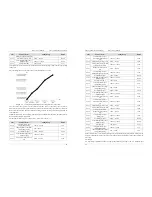
EM11 User’s Manual
5. Description of Function Codes
39
Commands are given by pressing keys “RUN” and “STOP/RESET” on the operation panel.
1: Terminal control
("LOCAL/REMOT" indicator on)
Commands are given by means of multifunctional input terminals with functions such as FWD, REV, JOGF,
and JOGR.
2: Communication control
("LOCAL/REMOT" indicator blinking)
Commands are given from host computer. For more details please refer to the appendix of communication
protocol.
Code
Parameter Name
Setting Range
Default
b0-03
Main frequency source X
selection
0: Digital setting (Preset frequency b0-12,
UP/DOWN modifiable, no-record after
power off)
1: Digital setting (Preset frequency b0-12,
UP/DOWN modifiable, record after power
off)
2: AI1
3: AI2
4: AI3
5: Pulse setting (DI6)
6: Multi-function
7:Built-in PLC
8: PID
9: Communication setting
0
It is used to select the setting channel of the main frequency. You can set the main frequency in the
following 10 channels:
0: Digital setting
(Preset frequency b0-12, UP/DOWN modifiable, not record at power failure)
The initial value of the set frequency is the value of b0-12 (Preset frequency). You can change the set
frequency by pressing and
on the operation panel (or using the UP/DOWN function of input
terminals).
When the Frequency inverter is powered on again after power failure, the set frequency reverts to the value
of b0-12.
1: Digital setting
(Preset frequency b0-12, UP/DOWN modifiable, record at power failure)
The initial value of the set frequency is the value of b0-12 (Preset frequency). You can change the set
frequency by pressing keys
and
on the operation panel (or using the UP/DOWN functions of input
terminals).
When the frequency inverter is powered on again after power failure, the setting frequency is the value
memorized at the moment of the last power failure.
Note that b0-10 (record digital setting frequency of power failure) determines whether the set frequency is
memorized or cleared when the frequency inverter stops. It is related to stopping rather than power failure.
2: AI1
3: AI2
4: AI3
The frequency is set by analog input. The EM11 control board provides two analog input (AI) terminals
(AI1, AI2). Another AI terminal (AI3) is provided by the I/O extension card.
Including:
AI1: 0V~10 V voltage input;
AI2: 0V~10 V voltage input or 4mA~20 mA current input, determined by jumper on the control card;
AI3: -10V~10 V voltage input
The corresponding relationship curve between the input voltage of AI1, AI2 and AI3 and the target
frequency can be user-defined.
When AI is used as the frequency setting source, the corresponding value 100% of the voltage/current input
corresponds to the value of b0-13 (Maximum frequency).
5: Pulse setting (DI6)
The frequency is set by DI6 (high-speed pulse). The signal specification of pulse setting is 9V~30V (voltage
range) and 0 kHz~100 kHz (frequency range). Pulse can be only input by DI6.
5. Description of Function Codes
EM11 User’s Manual
40
The relation between DI6 terminal input pulse frequency and corresponding setting is set by b5-00~ b5-03.
The corresponding relation is the linear relation of these two points. The corresponding value 100% of pulse
setting corresponds to the value of b0-13 (Maximum frequency).
6: Multi-function
In Multi-segment speed mode, combinations of different DI terminal states correspond to different set
frequencies. The EM11 supports a maximum of 16 speeds implemented by 16 state combinations of four DI
terminals (set with functions 12 to 15) in Group C1. The multiple segments speed indicates percentages of
the value of b0-13 (Maximum frequency).
If a DI terminal is used for the Multi-function function, you need to perform related setting in group b3. For
details, refer to the descriptions of Group b3.
7: Simple PLC (built-in)
When the simple programmable logic controller (PLC) mode is used as the frequency source, the running
frequency of the frequency inverter can be switched over among the 16 frequency references. You can set
the holding time and acceleration/deceleration time of the 16 frequency references. For details, refer to the
descriptions of Group C2.
8: PID
The output of PID control is used as the running frequency. PID control is generally used in on-site
closed-loop control, such as constant pressure closed-loop control and constant tension closed-loop control.
When applying PID as the frequency source, you need to set parameters of “PID function” in group C0.
9: Communication setting
The frequency is set by means of communication.
Code
Parameter Name
Setting Range
Default
b0-04
Auxiliary frequency source Y
selection
0: Digital setting (Preset frequency b0-12,
UP/DOWN modifiable, no-record after
power off)
1: Digital setting (Preset frequency b0-12,
UP/DOWN modifiable, record after power
off)
2: AI1
3: AI2
4: AI3
5: Pulse setting (DI6)
6: Multi-function
7:Built-in PLC
8: PID
9: Communication setting
1
When used as an independent frequency input channel (frequency source switched over from X to Y), the
auxiliary frequency source Y is used in the same way as the main frequency source X (refer to b0-03).
When the auxiliary frequency source is used for operation (frequency source is "X and Y operation"), pay
attention to the following aspects:
1.
If the auxiliary frequency source Y is digital setting, the preset frequency (b0-12) does not take effect.
You can directly adjust the set main frequency by pressing keys
and
on the operation panel (or
using the UP/DOWN function of input terminals).
2.
If the auxiliary frequency source is analog input (AI1, AI2 and AI3) or pulse setting, 100% of the input
corresponds to the range of the auxiliary frequency Y (set in b0-05 and b0-06).
3.
If the auxiliary frequency source is pulse setting, it is similar to analog input.
Note:
The main frequency source X and auxiliary frequency source Y must not use the same channel. That
is, b0-03 and b0-04 cannot be set to the same value in case of confusion.
Code
Parameter Name
Setting Range
Default
b0-05
Selection of auxiliary frequency
Y range
0: Relative to maximum frequency
1: Relative to main frequency X
0
b0-06
Range of auxiliary frequency Y 0%~150%
100%
















































